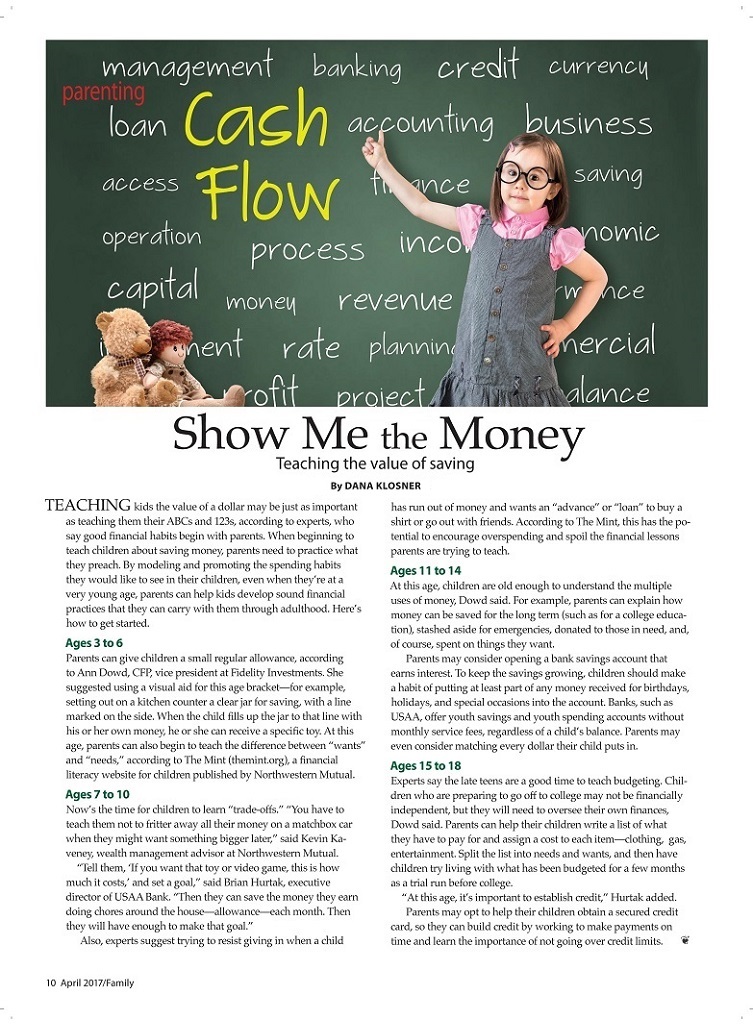parenting
management banking credit currency loan Cash accounting business access
the ance po saving process incon n omic
i w ince i onent rate planning Enercial P r ofit project. une bi alance
Show Me the Money
capital money
revenue
Teaching the value of saving
By DANA KLOSNER TEACHING kids the value of a dollar may be just as important has run out of money and wants an “advance” or “loan” to buy a
as teaching them their ABCs and 123s, according to experts, who shirt or go out with friends. According to The Mint, this has the posay good financial habits begin with parents. When beginning to tential to encourage overspending and spoil the financial lessons teach children about saving money, parents need to practice what parents are trying to teach. they preach. By modeling and promoting the spending habits
Ages 11 to 14 they would like to see in their children, even when they’re at a
At this age, children are old enough to understand the multiple very young age, parents can help kids develop sound financial
Lises of money, Dowd said. For example, parents can explain how practices that they can carry with them through adulthood. Here’s
money can be saved for the long term (such as for a college educahow to get started.
tion), stashed aside for emergencies, donated to those in need, and, Ages 3 to 6
of course, spent on things they want. Parents can give children a small regular allowance, according
Parents may consider opening a bank savings account that to Ann Dowd, CFP, vice president at Fidelity Investments. She earns interest. To keep the savings growing, children should make suggested using a visual aid for this age bracket–for example, a habit of putting at least part of any money received for birthdays, setting out on a kitchen counter a clear jar for saving, with a line holidays, and special occasions into the account. Banks, such as marked on the side. When the child fills up the jar to that line with USAA, offer youth savings and youth spending accounts without his or her own money, he or she can receive a specific toy. At this monthly service fees, regardless of a child’s balance. Parents may age, parents can also begin to teach the difference between “wants” even consider matching every dollar their child puts in and “needs, according to The Mint (themint.org), a financial
Ages 15 to 18 literacy website for children published by Northwestern Mutual.
Experts say the late teens are a good time to teach budgeting. ChilAges 7 to 10
dren who are preparing to go off to college may not be financially Now’s the time for children to learn “trade-offs.” “You have to
independent, but they will need to oversee their own finances, teach them not to fritter away all their money on a matchbox car Dowd said. Parents can help their children write a list of what when they might want something bigger later,” said Kevin Ka they have to pay for and assign a cost to each item-clothing, gas, veney, wealth management advisor at Northwestern Mutual. entertainment. Split the list into needs and wants, and then have “Tell them, ‘If you want that toy or video game, this is how
children try living with what has been budgeted for a few months much it costs,’ and set a goal,” said Brian Hurtak, executive
as a trial run before college. director of USAA Bank. “Then they can save the money they earn “At this age, it’s important to establish credit,” Hurtak added. doing chores around the house allowance each month. Then
Parents may opt to help their children obtain a secured credit they will have enough to make that goal.”
card, so they can build credit by working to make payments on Also, experts suggest trying to resist giving in when a child time and learn the importance of not going over credit limits.
10 April 2017/Family
